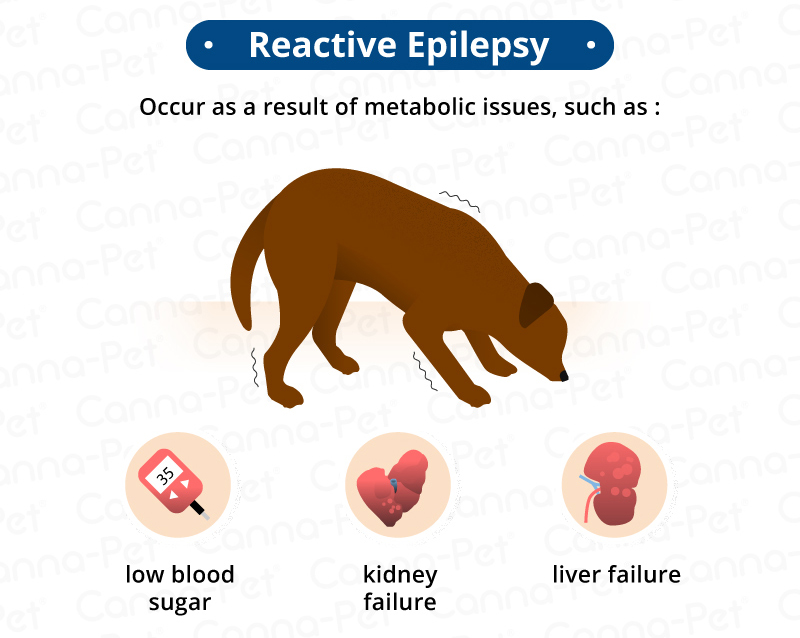As a dog owner, it is important to understand that your four-legged friend shares a lot of common health concerns with humans. For example, in addition to such conditions as seasonal allergies, diabetes, arthritis and even cancer, your pooch can have seizures just as humans do. In fact, epilepsy in dogs is one of the most common long-term neurological canine disorders.
A chronic condition that causes dogs to have repeated seizures, epilepsy can be a source of great distress for owners, particularly if it’s the first time you are witnessing this disorder in your beloved pet. However, with proper education, treatment, and a keen level of awareness, you can help to preserve your dog’s health and quality of life and minimize certain triggers along with your vet’s guidance and supervision.
Epilepsy in Dogs: Understanding Your Dog’s Condition
For most dogs, epilepsy is a lifelong disease requiring a regimented routine of care and treatment as prescribed by your veterinarian. A canine seizure is the result of abnormal electrical activity in the brain which leads to sudden but short-term disturbances in your dog’s behavior and physical movements.
Epilepsy, also known as status epilepticus, is a general term for neurologic abnormalities that cause recurring seizures and can last for longer periods of time. These seizures can be caused by trauma, toxins, brain tumors, infections or issues with your dog’s blood or organs. Your dog may or may not lose consciousness with these types of seizures. If your dog experiences more than one episode of seizures, he may be diagnosed as epileptic.
There are a variety of causes for dog epilepsy, such as brain tumors, toxins, low blood sugar, problems with specific organs, and more. Types of epilepsy are generally classified by the causes. Although there is such a variety of causes, sometimes we don’t know the causes of seizures. Those types of seizures are called idiopathic. Some breeds have a higher predisposition for the condition. Certain types of seizures are also genetic in nature and therefore hereditary. As a result, most experts recommend against breeding dogs who have been diagnosed as epileptic, as the trait can be passed along to offspring.
Signs That Your Dog May Be Epileptic
If you believe your dog may be suffering from canine epilepsy, it is crucial to make an appointment with your vet immediately for a complete physical evaluation, particularly if it’s the first time he or she has had a seizure.
Once your pet’s physician has conducted a thorough examination, including bloodwork and other tests, he will consider whether or not your dog has had at least two separate seizure episodes more than 24 hours apart. Because certain signs can be symptomatic of other diseases or underlying health conditions, it’s important to provide your vet with as much information about your pet’s condition as possible during your visit.
Some primary symptoms of dog epilepsy include:
- ‘Paddling’ of the legs (as though he’s treading water)
- Collapsing or falling down to one side
- Excessive drooling or foaming at the mouth
- Frenzied barking or whining
- Head shaking
- Incontinence (loss of normal bowel/urinary control)
- Irregular seizure attacks that commence and finish suddenly
- Loss of consciousness
- Marked mental/behavioral changes
- Mild convulsions (such as twitching and jerking motions)
- Muscle twitching and spasms (especially noted in the face)
- Signs of panic, bewilderment, or confusion; dazed or ‘far away’ look
- Stiffness of the extremities
- Teeth chomping; chewing
- Temporary loss of vision
- Uncontrollable shaking and tremors
- Vomiting
- Weakness
- Epileptic attacks with symptoms that appear similar each time
In addition to recognizing the signs and symptoms of epilepsy in dogs, it’s helpful to speak candidly with your vet and ask any questions you might have about preventative care, medication, treatment, therapy, diet, and even possible dog epilepsy triggers.
Knowing what a dog seizure looks like and how to react can be invaluable moving ahead when it comes to managing your pet’s epilepsy. There are a number of causes for seizures in your dog, including insulinoma (low blood sugar) in older dogs, hypoglycemia (another form of low blood sugar) in puppies, and toxicities (such as ingesting certain types of foods, insecticides or rat poison) in dogs of all ages.
Causes and Classifications of Epilepsy in Dogs
There are many different reasons why your dog may experience a seizure – while some are preventable, others may be related to illness or even genetically-based in nature. This section breaks down the types of epilepsy found in dogs and related seizure conditions, along with other common causes for dog seizures.
In the case of canine epilepsy, there are numerous factors that need to be taken into account, including diseases that can cause seizures and lead to epileptic conditions. More specifically, epilepsy can be classified into two distinctions: structural, whereas an underlying cause may be identified in the brain, and idiopathic, whereas there is no identifiable underlying cause; in the latter, it is often presumed that a genetic predisposition is the case or that the cause is unknown.
- Idiopathic Epilepsy: Typically, a combination of genetic and environmental factors, idiopathic epilepsy most frequently affects young to middle-age dogs (6 months – 6 years old) where there appears to be no underlying cause for repeated seizures. In order for your vet to properly diagnose idiopathic epilepsy, he will have to rule out certain causes, such as specific diseases or illness. Your vet will base his diagnosis on your dog’s medical history, lab tests (blood and/or urine) and an EEG (a neurological exam that tracks electrical activity in the brain). In addition, he may choose to run an MRI (brain scan) as well as a spinal tap (i.e., analyze his cerebrospinal fluid) to further investigate possible causes for your dog’s seizures.
- Structural Epilepsy: For some dogs who experience seizures, the underlying cause can be linked directly to brain function. Your vet will be able to determine the exact nature of the brain abnormalities in question, which can range from obstruction and insufficient blood supply to bleeding, infection, inflammation, head trauma, brain tumors, developmental problems, and even degenerative brain diseases. Your dog’s physician will be able to diagnose the problem via MRI and/or cerebrospinal fluid analysis (CSF or spinal tap).
- Reactive Seizure: This condition is the result of metabolic issues, such as low blood sugar, kidney failure, or liver failure
Other common dog epilepsy causes include:
Genetics & Breed: In the case of genetic epilepsy, symptoms typically occur between 10 months and 3 years of age, but in certain cases, it can appear as early as 6 months and as old as 5 years. As mentioned earlier, there are certain breeds that are more prone to epilepsy and other forms of seizures. These breeds include:
- Beagle
- Belgian Tervuren
- Bernese Mountain Dog
- Collie
- Cocker Spaniel
- Dachshund
- English Springer Spaniel
- Finnish Spitz
- German Shepherd
- Golden Retriever
- Irish Setter
- Irish Wolfhound
- Keeshond
- Labrador Retriever
- Miniature Schnauzer
- Poodle
- Siberian Husky
- Saint Bernard
- Shetland Sheepdog
- Yorkie Poo
- Vizsla
Environmental Factors: Protecting your dog from poisonous materials (including those found in your home and outdoors) is one area where your due diligence can save your dog from harm’s way. Toxins may present themselves in a number of ways, including food items, pesticides, harmful chemicals, and other dangerous substances that can result in health complications, including seizures. Be sure to pet-proof your home and always monitor your dog’s activities carefully to avoid accidental ingestion of toxic materials.
Head injuries are also another common accident that can occur at any time. Therefore, it’s important to keep your dog as safe as possible and practice precautions whenever you can, particularly around your home, during car trips, and while going for walks. Using common sense and good judgment can sometimes be the greatest safety measure when it comes to our pet’s welfare.
Health Issues: There are certain health issues that can cause seizure episodes in your dog; these conditions include, but are not limited to, anemia, kidney disease, liver disease, brain cancer, encephalitis, electrolyte problems, and blood pressure abnormalities (too high/too low).
It should also be noted that male dogs are more prone to seizures than female dogs. In addition, the age at which your dog experiences his first seizure episode can determine whether or not they’ll continue throughout his lifetime, how often you can expect them, and the long-term outcome. Discussing your dog’s prognosis and type of epilepsy can help you to better understand his condition as well as determine a course of treatment. Depending on your dog’s specific condition, your vet can provide you with an idea of his life expectancy.
Other Epilepsy Classifications:
In addition to classifying epilepsy by its cause (idiopathic or structural), The International Veterinary Epilepsy Task Force proposed a classification system according to where it begins in the brain as well as characteristics of the event. There are several other types of seizures in dogs, common types include:
- Grand Mal Seizures: (also called tonic-clonic seizures) – a generalized seizure that occurs in both sides of the brain in which a dog convulses and can lose consciousness
- Focal Seizures: seizures that originate from one part of the brain, resulting in only affecting a certain part of the body
- Cluster Seizures: a group of seizures that occur in a short time interval, this is clinically defined as more than two seizures in a 24-hour period
- Myoclonic Epilepsy: sudden, short contractions of a muscle
- Tonic Seizure: a brief seizure that involves sudden stiffening of the muscles
Knowing Your Dog’s Epilepsy Triggers
In some instances, you may notice that your dog has certain ‘triggers’ that can lead to his seizure. However, this may not be the case in all dogs, and triggers may vary between each animal. Many pet owners have noted that anxiety plays an influential part in their dog’s epileptic episodes, and have reported a variety of different situations, including a change in environment or routine, thunderstorms, car rides, and trips to the vet, among others.
In addition, some pet parents have noted that their dogs seem hypersensitive to certain types of medications and food, which seem to trigger seizures. Keeping this information in mind, one of the most proactive things you can do is to keep a seizure diary of your dog’s episodes – by recording the details of each incident, you can help determine possible environmental triggers and provide your vet with helpful information that can help to formulate an effective course of treatment.
Treating Your Dog’s Epilepsy: Speak with Your Vet
Although epilepsy is usually a lifelong and chronic condition, your vet can determine the best treatment options to ensure your dog’s quality of life. Certain factors such as type of seizure, the severity of seizures, how often your dog has a seizure, and if he has any problems with his kidney or liver will factor into the course of treatment your vet recommends.
If your vet prescribes anticonvulsant medication, be sure to discuss the dose and administration protocols thoroughly. Furthermore, following up with your vet on a routine basis to monitor your dog’s condition and his reaction to the medication is essential. Because most cases of chronic epilepsy require lifelong treatment, periodic check-ups and blood tests will be required. Phenobarbital and Potassium Bromide are two medicines that are commonly prescribed for dog epilepsy. Phenobarbital is used for idiopathic epilepsy and Potassium Bromide is a secondary prescription that can be used if your dog doesn’t react well to Phenobarbital.
In addition to medication, your dog’s vet may suggest changes in his diet. You may wish to discuss the benefits of dietary and nutritional supplements to further enhance his overall health and brain/organ function. It’s also important to maintain a consistent source of nutrition (i.e., not constantly switching dog foods, etc.), as changes to what he eats can alter his blood levels and how they respond to certain medications. Along with a change in diet, your vet may also recommend other natural alternatives to prescription medication for epileptic dogs.
Recent advances in medicine include the development of a new dietary regimen for dogs, which may help to control your dog’s seizures. Discuss pet food options with your vet, and always keep the following in mind if your dog requires medication for his epilepsy:
- Be sure to administer medication at the same time each day
- Always give them the correct dosage
- Do not stop any dog seizure treatment without first consulting with your veterinarian
- Keep a journal of your dog’s seizures and share results with your vet to track and monitor his progress, as well as help to identify ‘triggers’
Additional Tips for Dogs with Epilepsy
If your dog is suffering from seizures or is epileptic, it is understandable that you want to do whatever you can to make him as comfortable as possible and avoid certain activities to prevent future episodes. Here are a few helpful tips to keep in mind for pet parents who are still familiarizing themselves with this common disorder:
- Skip the salt: Studies have shown that foods and doggy treats high in sodium can actually cause seizures if they are on medications containing potassium bromide, so be sure to monitor your dog’s salt intake carefully and discuss a diet plan with your vet.
- Avoid the pool: Because your dog may have an epileptic episode while swimming, he can be at risk of drowning. Therefore, you may wish to explore other safer ways to exercise and play.
- Keep cool: During a long seizure, your dog is prone to overheating – one of the easiest ways to keep him cool is to put cold water on his paws and place a floor fan close by to help lower his body temperature until the episode is over.
- Avoid the mouth & muzzle: Contrary to popular belief, your dog can’t ‘swallow’ his tongue – be sure to keep hands away from your dog’s mouth during a seizure, as he may be prone to snap or bite. It’s also imperative to keep his airway free of any and all obstructions.
- Be mindful of episode length: If your dog has multiple seizures in a row (also known as ‘cluster seizures’) or one episode that lasts longer than 5 minutes, it’s important to bring him to your veterinary office immediately.
Reassuring your pet, removing any hazards from his environment (such as sharp-edged furniture), and even providing a pillow if he happens to be on a hard surface are all ways you can try to ease his discomfort if your dog is having a seizure.
Ultimately, as pet parents we want to treat epileptic seizures as compassionately as possible – depending on the underlying cause, your vet can help to treat your dog’s seizures to reduce their frequency and severity.
Full Dog Epilepsy Infographic
Sources:
- “Seizures in Dogs: Causes, Symptoms, & What to Do.” WebMD, Accessed 1 Mar. 2017. www.pets.webmd.com/dogs/dog-seizure-disorders.
- “Epilepsy in Dogs.” The Kennel Club, Accessed 1 Mar. 2017. www.thekennelclub.org.uk/health/for-owners/epilepsy/.
- “Identifying, Treating, and Preventing Seizures in Dogs.” The Spruce Pets, Accessed 1 Mar. 2017. www.thesprucepets.com/seizures-in-dogs-3384866.
- “Canine Epilepsy.” Pet Health Network, Accessed 1 Mar. 2017. www.pethealthnetwork.com/dog-health/dog-diseases-conditions-a-z/canine-epilepsy.
- “How to Treat Seizures and Brain Disease in Dogs.” The Spruce Pets, Accessed 1 Mar. 2017. www.thesprucepets.com/seizures-and-your-dog-1117421.
- “Diagnostic Approach to Epilepsy in Dogs.” NCBI, Accessed 23 Apr. 2019. www.ncbi.nlm.nih.gov/pmc/articles/PMC4552251/
- “Int’l Veterinary Epilepsy Task Force Consensus on Epilepsy.” BMC Veterinary Research, Accessed 23 Apr. 2019. www. bmcvetres.biomedcentral.com/articles/10.1186/s12917-015-0461-2

















